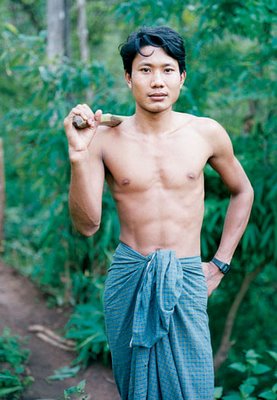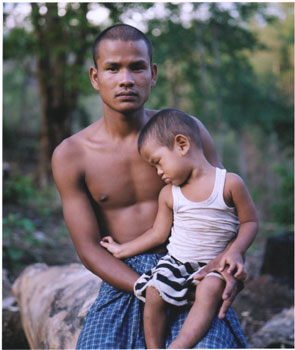"Burma is a golden land, the richest country in Asia, the envy of its neighbors; its people are the kindest, most hospitable on earth," says Amitav Ghosh in his afterword to Burma: Something Went Wrong, Chan Chao’s acclaimed book documenting his trips to his native country. With his art, Chao puts a face to one of the most troubled and least understood countries of our world. While Burma (now Myanmar) is a nation in violent conflict, Chao’s technique is to create a portrait featuring the refugees, pro-democracy insurgents, soldiers and others who populate the country, against the lush, colorful, fragrant backdrop of what is undoubtedly a beautiful country. The juxtaposition informs the viewer, that this is region, although in constant turmoil, is still a "golden land."
Chao, 34, immigrated to the United States with his family at age 12 and attended school in Prince George's and Montgomery counties, eventuallybecoming a student at the University of Maryland. One of his professors, John Gosage, introduced him to fine art photography.
Portraits and studio work were Chao's specialty. In an exhibition space behind the Burma portraits is an installation of some of his earlier work, edgy black-and-white nudes, images a world apart from those ofthe refugee camps. Although the damaged bodies and faces in the exhibit's small color portraits attest to the fact that the camps can be hazardous, Chao said he never felt endangered. He went to meet relatives, not take pictures, he said.
Ultimately, though, his motive was introspective: self-discovery. "I only felt I wanted to go back when I was turning about 30," he said. "I started to reexamine myself and ask, 'Who am I? What's my background?' " So, in 1996, he bought a ticket, applied for a visa and was given aresounding "No" from the embassy of Burma. The reason, he said, is that his father supports the democracy movement there. Chao used his ticket to visit friends in Asia instead, figuring that he'd try Burma again when he was closer.
He did, this time from Jakarta, and still couldn't obtain a visa. "I was crushed," he said. A friend in Thailand offered to help, and at least Thailand was closer to Burma. "That's when I decided to go to the border," he said. "Since I was this close, I might as well try to getsome experience of going back to Burma."
Civil unrest has plagued Burma since its independence from Britain in the 1940s, and the border is riddled with refugee camps. As Chao's photos attest, the camps are multiethnic and multigenerational. People in them wear sarongs, fatigues, polo shirts; they hold guitars, guns, children. It's an existence marked by grindingly prosaic concerns and a twilight uncertainty.
Chao revisited the Thai-Burma border in 1997 and went to the India-Burma border in 1998. The Indian border was more remote, harder to reach and in the middle of its own ethnic battles. Chao felt he had to go there, he said, because it was the closest point, geographically, to the part of Burma his family came from.
The photographer credits the Burmese government with launching the project: "Had they given me a visa, I don't think I would have gotten involved so politically. I would have been more of a tourist."










Questions:
- How would you compare Chan Chao's work to the work of Rienke Dijkstra, from Ch. 3? How is it similar, how is it different?
- What do you think of the relationship between the images and the title of the series, "Burma- Something Went Wrong?"
- Why do you think Chan's inability to get a legitimate visa effected his choice of how to photograph?

7 comments:
I think these images are fantastic and very thought provoking. Chao used a very wonderful way of presenting his country to others. In my opinion, the best way to express a country is through its people. Chao used just this as his subject matter. I admire how he shows the various ethnic groups and ages within the country. In these images was everything from a soldier to a young girl decked out in her cultural jewelry. It shows these people in their natural environments of the country – making it so raw and uncut. This is who these people are. This is what they do. This is where they live. All around, I both admire and take an interest in his work here.
I agree with amdylong in that a country is a direct representation of the people within it. Chan Chao's work is amazing in its brilliance and clarity of color and photographing a wide variety of people in their own environment.
These pictures are similar to Rienke Dijkstra photos. If one was looking at the two artist they would notice that they are both taking full fronting pictures of their subjects. A difference that they would see is their choice of background. In these photos the back ground has more of a busy background while in Dijkstra's artwork we see simple things such as the oceans. I enjoy these photos more because you can tell a more interesting story with what you see.
~Brandi Ashlock
I don't care much for these photos. The obvious portrait look of them, in my mind, provides a disconnect from the situation. The historical nature of the piece is almost lost because the pictures look staged.
How would you compare Chan Chao's work to the work of Rienke Dijkstra, from Ch. 3? How is it similar, how is it different?
One major difference is that Dijkstra's photographs focused solely on the subjects, whereas in Chao's work, the backgrounds are just as important as the people in them. Dijkstra's work wanted to capture young adults in phases of change, and Chao wanted to capture a range of people you may find in the "Golden" country of Burma; using the backdrop to reinforce the beauty of the country. Chao's work does not descriminate by age.
Perhaps the greatest difference is that Dijkstra's images communicate an internal conflict through the expressions of his subjects, and Chao's images help you imagine a very real conflict involving the people you see in the settings you also see.
The portrait against a natural backdrop makes the pictures similar to Dijkestra's work, except in this instance, like Danish states, is more significant. It is the background, the place where they live, that causes the turmoil or conflict; it's not internal. Also, I feel like these pictures have more emotion to them; they are not quite as "deadpan" even though they are shot similarly.
I think the title of the series, "Burma- Something Went Wrong" relates to the images in that what the artist is showing us is that something has gone wrong to make such a stunning place become so devastated. The subjects seem out of place; there shouldn’t be such hardship in such a beautiful land.
I can understand why his denial of a Visa would push him even further to make a political statement. You want something even more when you are denied it.
Chan Chao has described his work as very much kind of selfreckoning. So says in the book. I look and read what Chan Chao is saying and to me it like their are conducting their lives in displaced communities. As reading the who chapter 6. I felt like everything had a questioning of documentary truth about a picture. These pictures are very moving and makes you think what is about the picture of someone who had be pushed away by visa.
Post a Comment